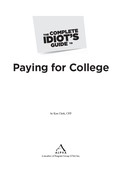Denial and Procrastination
Make no mistake about it, getting college paid for is not just about acquiring knowledge about programs and options. Getting college paid for is also a race to the finish, against both the calendar and other students and families. Just as there are only so many spots available at any given college, there is only so much money to go around for students in need.

CHEAT SHEET
When I do the orientation for new students at one of the colleges I teach at, I give them a fake check and have them make it out to themselves for $1,000,000 (the average increase in lifetime earnings for a graduate). I then have them post that on their fridge or next to their computer to help them overcome their procrastination and denial. What can you post somewhere visible to help you push through the difficult days? A check? A diploma with your name on it? A picture of graduating students?
So I bet you already know the punch line of this little lecture then, don’t you? Denial and procrastination are your enemies. If you wait to begin thinking about what you need to do until after your vacation ends, the next holiday is over, or this current school year passes, you’ll only be hurting your chances and exponentially increasing the amount of work you’ll have to do later. As an antidote to these temptations, you have to truly embrace two things by the end of this book—working your plan and finding a partner in crime.
Mistake #1: Not Working Your Plan
Nike, perhaps as much as any company, is famous for its motto. What makes “Just do it” so catchy is not just what it says, but also what it doesn’t say. It’s a subtle jab at all those who dream big, think big, or make big commitments, but then for some reason fail to take action. It’s a short reply to the long list of excuses: shut up, and just do it.
Hopefully, as this book draws to a close, you’ve begun to formulate a pretty solid action plan, whether you’ve used my College Cash Strategy Worksheet in Appendix B or formulated your own unique hit list of items. For that, I’m very proud of you and you should be proud of yourself. But, at the same time, I can guarantee you that there will be those who read this book and draw up a great strategy but never get around to the day-to-day action required to reach their funding goals.
Whether it is every day, every weekend, or once a month, you need to set aside time to perform the action steps on your College Cash Strategy Worksheet. If you don’t, or don’t consistently, I can guarantee that you will have nothing to show for it and your college dreams will slip through your fingers. If you can do it, if you can work your plan, slowly but surely things will begin to happen.
Mistake #2: Doing It Alone
Chances are that you’re not the only person you know who is being terrorized by the ogre of tuition. If you’re a student reading this book, there’s no doubt that you have friends who are in the same boat financially. If you’re a parent reading this book, chances are that your friends (or the parents of your kids’ friends) are fighting the same battle. So before you charge off into the college funding wilderness all alone with a torch and a pitchfork, it might be wise to round up some of the local townsfolk.

CHEAT SHEET
Most colleges have newsletters, online forums, and support groups for parents and students. These can be great places to stay up-to-date on everything happening at your school, trade financial aid information and ideas, and learn cost-cutting tricks particular to your school. If you can’t find one, consider starting one!
I suggest creating a group that meets regularly and whose goal is to get college paid for, whether it be for themselves or someone else. It’s almost like a knitting group, except you’re filling out scholarship applications instead of making a sweater for your dog.
The group could be as small as 2 people or as big as 10 to 12 (it gets a little chaotic with more than that) and would ideally meet once per month for 1 or 2 hours. You use the time to share your goals, progress, and ideas. You could even share research duties, spreading the workload around and having everyone report their findings on various funding opportunities. At the end of the meeting, you’ll set a goal that everyone should accomplish by the following meeting, such as submitting four scholarship applications and finding four new ones.
Here’s what a monthly, two-hour meeting might look like:
5:00-5:30 Potluck dinner
5:30-6:00 Update on each person’s college funding strategy (goals, progress, and so on)
6:00-6:15 Share research
6:15-6:30 Assign research for next meeting
6:30-7:00 Fill out one application together
..................Content has been hidden....................
You can't read the all page of ebook, please click here login for view all page.
